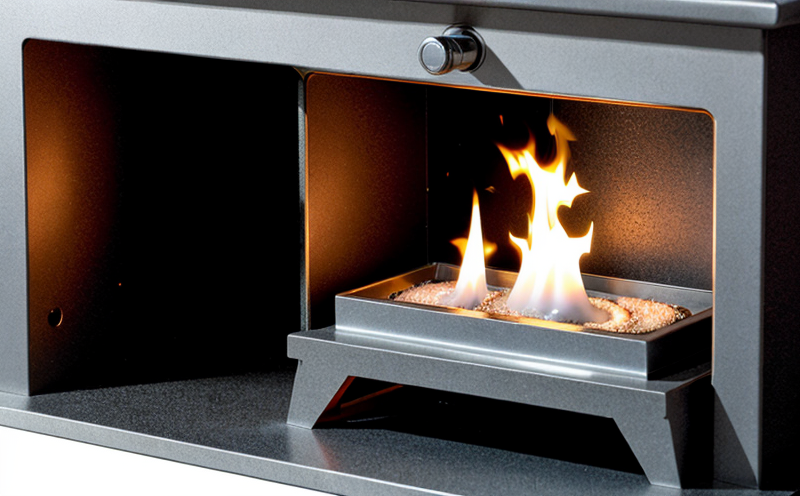Surface Flame Spread Testing of Composite Panels
In fire safety testing, surface flame spread is a critical parameter that assesses how quickly and easily flames can spread across the surface of materials. This test is particularly important for composite panels used in various sectors such as construction, automotive, and furniture manufacturing. The objective is to evaluate the ignition behavior and flame spread characteristics of these panels under controlled conditions.
The testing procedure involves placing a standardized specimen on a metal support frame and exposing it to a specified heat source. The heat source is typically an open flame or a gas burner that generates consistent temperatures at a defined rate. Once ignited, the flame spreads across the surface of the panel, and the tester measures the distance the flame travels over time. This measurement helps in categorizing the material into different classes based on its flame spread performance.
The apparatus used for this test includes a calorimeter to measure heat release rates and a video camera or photometer to record the flame front movement accurately. The testing environment must be controlled, with specific humidity and temperature conditions to ensure consistent results across tests. Compliance with international standards such as ASTM E84-21a is crucial to validate the test results.
Specimen preparation for surface flame spread testing of composite panels involves cutting standard-size samples according to the specified dimensions in the relevant standards. The edges of these specimens are typically smoothed and cleaned to avoid any irregularities that could affect the outcome of the test. Proper labeling of each specimen is also essential to maintain accurate records.
The test results provide valuable insights into the fire resistance capabilities of composite panels, helping manufacturers make informed decisions about material composition and design improvements. These insights can lead to safer products by reducing the risk of rapid flame spread in case of a fire outbreak.
Understanding the underlying principles of surface flame spread testing ensures that quality managers and compliance officers can effectively manage their processes and ensure adherence to regulatory requirements. This knowledge is also beneficial for R&D engineers who are developing new composite materials or improving existing ones, as well as procurement professionals looking for reliable suppliers.
Benefits
The benefits of conducting surface flame spread testing on composite panels extend beyond ensuring compliance with fire safety regulations. These tests provide valuable data that can be used to enhance the performance and safety features of products. By identifying the ignition behavior and flame spread characteristics, manufacturers can optimize their product design to minimize potential risks associated with fire hazards.
One significant benefit is improved product quality. The testing process helps in refining the manufacturing processes and selecting appropriate materials for use in composite panels. This optimization ensures that the final product meets or exceeds the required standards, thereby enhancing its overall performance and reliability.
Another advantage is increased market competitiveness. By demonstrating a commitment to fire safety through rigorous testing, companies can gain a competitive edge over their peers. This can lead to higher customer trust and loyalty, which in turn translates into better sales and brand reputation.
Moreover, surface flame spread testing supports innovation by encouraging ongoing research and development efforts aimed at creating more advanced composite materials with improved fire resistance properties. This continuous improvement ensures that products remain up-to-date with the latest safety standards and consumer expectations.
The results of these tests can also be used to provide third-party certifications and endorsements from recognized bodies, further enhancing credibility and trustworthiness among consumers and industry stakeholders.
International Acceptance and Recognition
The surface flame spread testing of composite panels is widely recognized and accepted across many international standards. ASTM E84-21a is one such standard that provides a standardized method for determining the relative burning characteristics of building materials using both smoke development and flame spread indices.
EN 13501-1:2016 also covers similar aspects but focuses more on fire behavior, propagation, and structural integrity. Both standards are designed to ensure consistent testing methods and results globally. Compliance with these standards can help manufacturers meet global market demands while ensuring their products adhere to stringent safety regulations.
ISO 834:2017 specifies the details for determining the resistance of materials used in building construction to fire, providing additional guidance on conducting flame spread tests under various conditions. These international standards not only ensure consistency but also facilitate trade by eliminating discrepancies between different countries' requirements.
The acceptance and recognition of these testing methods are crucial as they provide a common framework for assessing fire performance internationally. This uniformity helps in maintaining high safety standards across all regions, fostering confidence among consumers who rely on tested materials for their homes or workplaces.
Competitive Advantage and Market Impact
The surface flame spread testing of composite panels plays a pivotal role in enhancing the competitive advantage and market impact of manufacturers. By demonstrating robust fire safety features, companies can differentiate themselves from competitors who may not prioritize such rigorous testing methods.
Clients often look for suppliers that offer products validated through comprehensive testing procedures like those outlined by ASTM E84-21a or EN 13501-1:2016. Compliance with these standards instills confidence in customers about the reliability and safety of the purchased materials, leading to increased business opportunities.
Furthermore, successful completion of surface flame spread testing can lead to certifications that are highly valued by both buyers and regulators alike. Such certifications not only enhance brand image but also open doors for international markets where stringent fire safety regulations apply.
Achieving competitive advantage through superior fire safety measures requires ongoing investment in research and development aimed at improving existing products or developing innovative solutions. This continuous effort ensures that manufacturers stay ahead of industry trends, meeting evolving consumer needs and regulatory requirements effectively.





